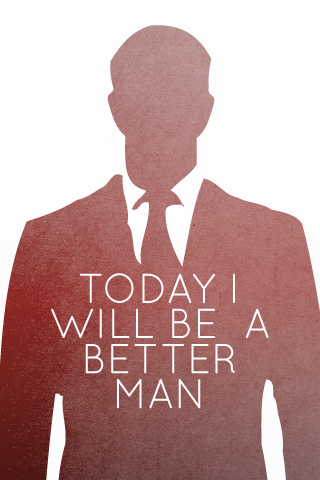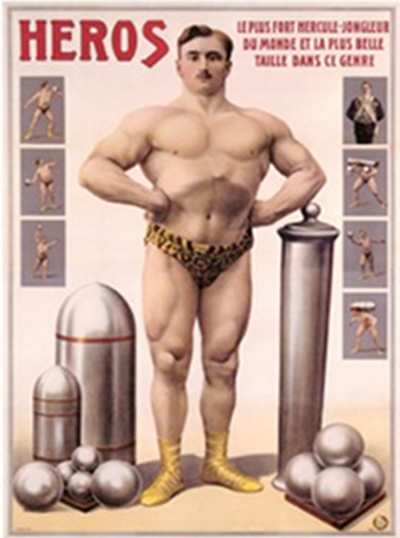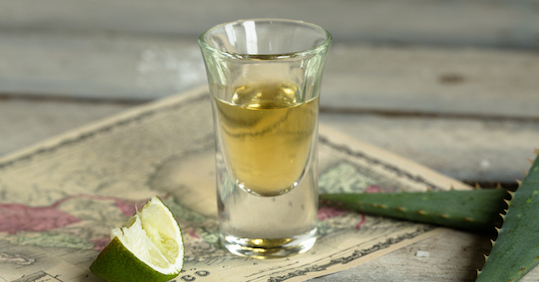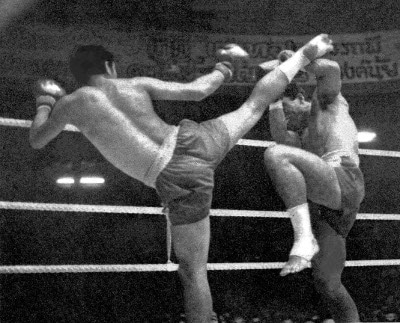
Editor’s note: This is a post from Bryan Schatz who has been guest posting for us the last couple of months and has now become a full-fledged Art of Manliness contributor. Welcome aboard, Bryan!
***
The monsoon downpour ends just before we hop out of the cab. We pay our 85 baht, thank the driver and step onto a blackened cement sidewalk where the air is heavy, almost suffocating in its heat and humidity. We can already smell the stench of stale sweat and struggle before we even reach the stadium. We walk past some dingy dogs lounging amongst the crowd outside, beyond the food vendors and Tuk Tuk drivers where we’re stopped by the ticket touts near the entrance.
Lumpini Stadium is grit and sweat. Mixed with blood. Most of it old and dried on the canvas but with fresh sprinkles from tonight’s fights. It’s a mass of hardened and stained cement, cigarette smoke, Chang beer, a piercingly loud audience, and of course, some brutal fights.
***
Muay Thai, the national sport of Thailand, is a combat sport like few others. Fighters use their knees, elbows, shins and hands to implement bone-crushing strikes. It is a martial art bound by thousands of years of tradition and flourishes in a society that flocks to the stadiums and nearest TV screens to catch the fights, often wagering what little they may have in the hopes of cashing in on some high-figure baht (the Thai currency) payout.
Thai fighters often begin their professional lives in the sport at ages as young as five and six years old, stepping into the ring to fight as frequently as two times a month. It is not uncommon for veteran Thai fighters to conclude their careers with several hundred fights under their belt. Shins are toughened by rolling glass bottles across them, kicking banana trees, and a lifetime of conditioning. With round after round of Thai pads, clench work, heavy bag work, sparring and more frequent fighting than any other martial art, training regimens are grueling and yet simply become a part of the every day rhythms of a fighter’s life.
Transcending Borders
But Muay Thai is not exclusive to the kingdom of Thailand. The sport has gained tremendous popularity throughout the world and is widely considered one of the most effective stand-up fighting forms. Seen as an increasingly crucial aspect of any MMA fighter’s arsenal as well as one of the toughest forms of kickboxing, it is used with mounting regularity in the Octagon and in K1 fights. MMA fighters such as Wanderlei Silva, Paul Daley and Anderson Silva are well-known for their backgrounds in Muay Thai. Gyms have opened their doors and sprung up all over the world teaching Thailand’s national sport. But the ultimate goal for many fighters these days is to travel to Thailand and train under Lumpinee Stadium Champions.
As someone who had trained in Muay Thai off and on for several years, I finally decided to take the plunge last year when my girlfriend Brittany and I took time off from work and school to get in some international traveling. Our first stop became Thailand, but before beginning a demanding training regimen, we hailed a tuk tuk and headed to Thailand’s most famous stadium in the heart of Bangkok: Lumpinee.
***
We try to walk past the ticket touts because I want to buy the cheap tickets for the back of the stadium, where the energy is ablaze and the betting is feverish. That is where I’d make my fortune. The touts try and convince you that the inexpensive seats are sold out, forcing you to fork over more dough for ringside seats. The chance of winning your cash back with some good old-fashioned gambling goes down the drain.
“1500 baht, ringside!” they call out as we scramble through the crowd of street dogs and noodle stalls.
“Nope, 500 baht, standing, with the old men betting in the back,” I respond.
They try again, so I say the same thing, and they shrug and let us pass to the ticket booth. There are three signs. The first one is the worst- it reads: 2,000 Baht- Ringside. The next: 1,500 Baht- Standing. And the kicker: 200 Baht- Thai Only.
Wait a second. What about the 500 baht deal I was told about? With the gamblers? In the back? Standing? A fortune…No?
“No.” They confirm at the counter. We turn around, and there’s the tout with a big happy grin on his face, a stack of tickets in hand. Dammit.
The History of Muay Thai
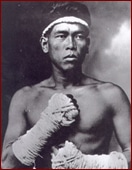
Though a form of Thai Boxing has been around for some 2,000 years, it can only definitively be traced back 400 years with records from the Ayuthaya era. Much scholarly debate surrounds the history of the sport predating this period
Early Muay Thai boxers fought bare-fisted, without regard to weight classes, or even skill level for that matter. The only necessary qualification was that each fighter expressed a willingness to fight. With a bare patch of earth as the ring and no actual rules, groin shots were fair game and heads could be used as weapons. At some point during the Ayuthaya period some of that changed. Fighters began wrapping their hands with strips of unrefined hemp to protect their wrists and fingers, making for more resilient and well-protected fists. This particular form became known as Muay Kaad Chuek and quickly spread.

Legend has it that fighters would dip their hands in water and let them dry; the hardened hemp was then capable of causing tremendous damage. Some stories suggest that the hemp was even occasionally impregnated with tiny shards of glass. An annual Muay Kaad Chuek contest is still held to this day at the Northeastern edge of the Thai/Lao border during Sonkran (the Thai New Year festivities), where the boxers fight until knockout, or, if both fighters are still standing at the end of the fight, it is declared a draw. Now of course, with sanctioning bodies and an international audience, Muay Thai has strict rules, with boxing gloves and wraps being mandatory.
***
1500 baht later and we’re sitting two rows back, the reedy Muay Thai music singing out its trance-nerve screech song on the other side of the ring while two fighters batter each other with their fists inside the ropes. The bell rings and the first fight ends in a unanimous decision; the guy with a crimson flood flowing from the cut above his eye loses. The crowd is wild with energy.
Muay Thai Children
The fact that children as young as five and six years old begin their careers in such a violent sport has obviously been a source of controversy. Children make their way to Muay Thai gyms for a variety of reasons. And though it sparks a serious human rights debate, Muay Thai “is a two-sided coin in Thai society. For these kids, it could mean an opportunity to flip their life’s crisis into a chance,” says Chira Wichaisuthikul, a Thai filmmaker whose documentary, Lumpinee, explores the world and significance of Muay Thai in a group of children’s lives. Some children come to the camps to escape a life of homelessness, drug addiction, and drifting. Others commit early purely for the love of the sport. As a result, boxing camps function as large family units in which coaches often fill the roles of absent fathers and daily activities are executed communally.
***
I can’t believe we’re finally here, and I look over to see the same excitement on Brittany’s face, except it isn’t quite there; she looks sleepy, and her eyes blink closed slowly.
The music begins again and two new fighters visit all corners of the ring and start their Ram Muay. The first rounds in a Muay Thai fight are generally slow, each fighter sizing up the other before firing off their cannons. Britt’s eyes droop a bit. Some more blinks. A yawn.
The later rounds set ablaze the entire stadium; the fighters become more and more energized and furious as they throw knees and kicks, fire off straight rights, swing viscous hooks and clench.
Tradition and Values

Suggesting that Muay Thai is simply a violent, human dog fight (as some do) is expected, but constitutes, in my opinion, a great misinterpretation of the sport. Though it is clearly violent, like many martial arts it also cultivates important values and traditions. In the proper atmosphere, it has the power to humble, discipline, and inspire.
For example, every Muay Thai fight is preceded by a “Wai Khru” (in which fighters visit each corner of the ring, claiming it as their own) and a “Ram Muay,” a traditional dance with the purpose of displaying respect to the fighter’s opponent and their camp, as well as appreciation for their own teachers, families and personal religion. Fighters wear a “mongkon” (traditional head bands) and a “Prajiad” around their biceps, both of which are believed to bring good luck.
Participation in any martial art has the possibility of bringing tremendous self-confidence as well as humility to an individual’s life, and Muay Thai is no exception.
***
I have never heard an audience so loud. With each knee, elbow, kick, and punch they respond with a chorus of “Hoo!” “Zyah!” and “Oh-Way!” The cheers grow in volume as the fights intensify.
The fighter in blue push-kicks his opponent in red in the face. “Zyah!” they all respond. Then he gets popped with a left hook and a round kick. Zyah! Oh-Way! Everyone’s screaming.
Britt’s head sags, and then she shakes the sleep away, and her eyes open for a second. Another yawn.
The Legend of Ramon Dekkers
As would be expected, Muay Thai has long been dominated by Thai fighters, and they hold onto to the Lumpinee Stadium championship belt with tightly clenched and powerful fists. There have been a few foreigners, however, who have risen to Muay Thai superstardom. One of those few is Ramon Dekkers. A Dutch native who pummeled his way through the competition, Dekkers has become a legend among Muay Thai enthusiasts for being one of the few foreigners to compete toe to toe with Thai fighters. At times he would fight up to two times a week if challenged, and like many of his Thai counterparts, he ended his career with over 200 fights.
***
Red controls the clench and is landing knees, one after another to Blue’s ribs. A Knee. Hoo! Another Knee. Hoo! Knee. Hoo! Knee. Hoo! Oh-Way! The fighter in blue drops to the canvas. Here come Britt’s eyes, opening briefly.
After an eight count the fighters are back at it, and Britt’s head slumps forward, eyes sealed shut. Red comes in to take advantage, he clenches, throws more knees again and again, and his opponent can’t stop them. He gets thrown back hard and smashed in the chin by an elbow. This time he hits the floor even harder. And it’s done. He’s knocked out cold and carelessly thrown onto a rickety wooden backboard, his arms limply dangling over the sides. The crowd goes berserk. They rush the fighter out of the stadium while the other’s arms are raised high in victory. My palms are wet with adrenaline. We all have fire in our eyes.
And Britt’s asleep on my shoulder.
It’s a good thing I didn’t get my cheap tickets with the old men betting in the back. For the fortune I sought to gain would have become a cash drought, Thai baht evaporating from my pockets like dew drops in a parched desert. I kept a mental log throughout the night of who I would have put my money on; I would have kissed my cash goodbye every time.
Those Interested in Training in Thailand
There are many who dream of training in Thailand, some of whom are not sure where to begin, how to go about finding a gym or accommodations, how to budget for the duration of the stay and travel expenses, or those who simply feel uncertain about their abilities and are therefore timid to try it out.
The first thing that should be made clear is that you do not have to be a professional fighter to train in Thailand, or even anything close to that. I trained (an amateur at best) alongside men and women of all ages and skill levels, some who were there to chase a title fight dream and others simply there for the exercise. Next week I will discuss the various gyms, accommodation types, hydration and food suggestions, and so on to hopefully provide at least a basic outline of what is available for those of you who are interested.
Tags: Self-Defense & Fighting



